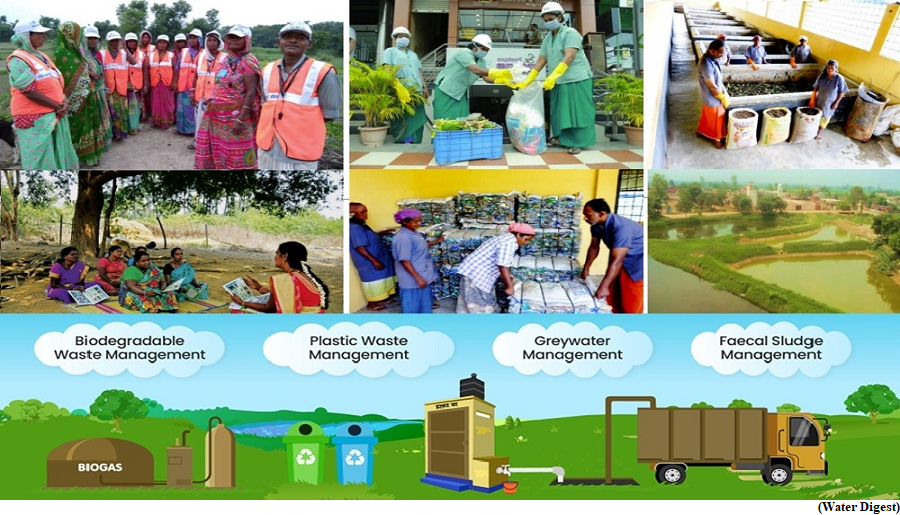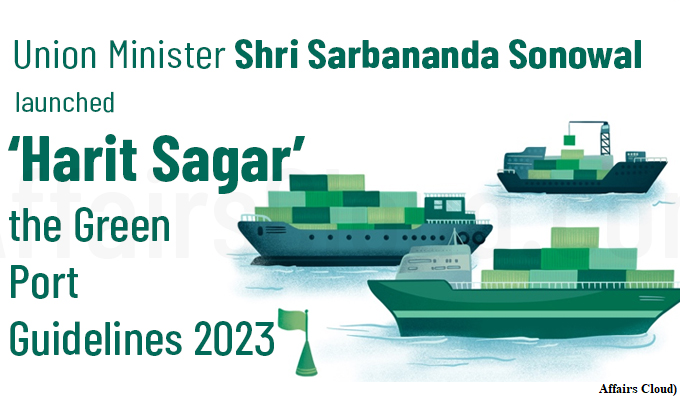50 percent Villages Are Now ODF Plus Under Swachh Bharat Mission Grameen Phase II (GS Paper 3, Government Scheme)

Why in news?
- India has achieved yet another major milestone under the Swachh Bharat Mission Gramin (SBM-G) with half of the total villages in the country i.e., 50% villages achieving ODF Plus status under phase II of the Mission.
Details:
- An ODF Plus village is one which has sustained its Open Defecation Free (ODF) status along with implementing either solid or liquid waste management systems.
- As on date, more than 2.96 lakh villages have declared themselves ODF Plus, which is a significant step towards achieving the SBM-G phase II goals by 2024-25.
Top performing states/UTs:
- The top performing states in terms of percentage of ODF Plus villages are - Telangana (100%), Karnataka (99.5%), Tamil Nadu (97.8%) & Uttar Pradesh (95.2%) among the big states and Goa (95.3%) and Sikkim (69.2%) among small states, are the top performer.
- Among UTs – Andaman & Nicobar Islands, Dadra Nagar Havelli & Daman Diu and Lakshadweep have 100% ODF Plus Model villages.
- These States & UTs have shown remarkable progress in achieving the ODF Plus status, and their efforts have been instrumental in reaching this milestone.
Background:
- Between 2014-15 and 2021-22, the Central Government has allocated a total of INR 83,938 crore to Swachh Bharat Mission Grameen. The allocation for the year 2023-24 is Rs. 52,137 Crore.
- In addition to the SBM(G) funds there is clear allocation of 15th FC funds for sanitation. These funds have been utilized to build sanitation assets, promote behavior change, and implement solid and liquid waste management systems.
- This year marks 9 years of the Swachh Bharat Mission. The achievement of 50% ODF Plus villages is a significant milestone for India as it is going beyond just construction and use of toilets towards complete and absolute cleanliness i.e., from ODF to ODF Plus.
Major components:
- The major components of the Phase-II of SBM (G) are Sustaining Open Defecation Free Status (ODF-S), Solid (Bio-degradable) Waste Management, Plastic Waste Management (PWM), Liquid Waste Management (LWM), Faecal Sludge Management (FSM), GOBARdhan, Information Education and Communication/Behavior Change Communication (IEC/BCC) and Capacity Building.
- The SBM-G program has been instrumental in improving the health and well-being of millions of people across the country. Several reports in the past few years have exhibited the ground impact of SBM-G programme.
- In terms of Plastic waste management, 831 Plastic Waste Management Units and 1,19,449 waste collection & segregation sheds have been set-up.
- The plastic is cleaned, shredded, bailed and transported for use in road construction as per the guidelines issued by the Ministry of Road Transport & Highways and also as a fuel in cement factories etc. More than 1 lakh Gram Panchayats have passed resolution for ban on Single Use Plastic (SUP).
Community compost pits constructed
- For Bio-degradable waste management at household level, people are being encouraged to segregate their dry and wet (organic) waste at source for composting at community level. 3,47,094 Community compost pits have been constructed, as on date.
- GOBARdhan, which stands for Galvanising Organic Bio-Agro Resources-dhan, is an initiative to support biodegradable waste recovery, conversion of waste into resources and for creating clean & green village.
- It is a ‘waste to wealth’ initiative wherein waste generated in villages is used to generate bio-gas/CBG as well as bio-slurry/bio-fertilizer and is in tune with the circular economy and Mission LiFE initiatives of GoI.
Constructed To Manage Grey Water:
- For Grey water management, which is the wastewater generated from everyday household chores- cleaning, cooking, bathing etc, in villages that do not have drainage systems, soak pits/leach pits or magic pits at household and community level can effectively treat grey water.
- A special campaign Sujlam was undertaken and approximately 2.2 million (22 lakh) soak pits (community & household pits) were made to manage grey water. Now, Sujalam 3.0 has been launched for holistic and convergent Greywater Management.
Way Forward:
- SBM(G) is a shining example of what can be achieved when there is a concerted effort to improve sanitation and hygiene.
- Department of Drinking Water & Sanitation, Ministry of Jal Shakti congratulates and applauds the contribution of all villages, Gram Panchayats, Districts, States/UT on this proud achievement.
Harit Sagar the Green Port Guidelines 2023 launched
(GS Paper 3, Infrastructure)
Why in news?
- To meet the larger vision of achieving Zero Carbon Emission Goal, Ministry of Ports, Shipping & Waterways has launched ‘Harit Sagar’ the Green Port Guidelines.

Details:
- Harit Sagar Guidelines - 2023 envisages ecosystem dynamics in port development, operation and maintenance while aligning with ’Working with Nature’ concept and minimizing impact on biotic components of harbor ecosystem.
- It lays emphasis on use of Clean / Green energy in Port operation, developing Port capabilities for storage, handling and bunkering Greener Fuels viz. Green Hydrogen, Green Ammonia, Green Methanol / Ethanol etc.
- These Guidelines provides a framework for the Major Ports for drawing out a comprehensive action plan for achieving targeted outcomes in terms of quantified reduction in carbon emission over defined timelines, through focused implementation and close monitoring of Green Initiatives and to achieve Sustainable Developmental Goals (SDG).
Objective:
- The objective of guidelines is to minimize waste through Reduce, Reuse, Repurpose and Recycle to attain zero waste discharge from port operations and promote monitoring, based on Environmental Performance Indicators.
- This also covers aspects of National Green Hydrogen Mission pertaining to ports, development of green hydrogen facility, LNG bunkering, Offshore Wind Energy etc and provides provision for adopting global Green Reporting Initiative (GRI) standard.
‘Sagar Shreshtha Samman’ awards:
- The award for the best Absolute Performance for the year 2022-23 conferred to the Deendayal Port, Kandla for handling highest cargo of 137.56 MMT.
- The Jawaharlal Nehru Port received award for achieving major milestone in Turn Around Time while Paradip Port got performance shield on Ship Berth Day Output.
- The Kamarajar Port got recognized in pre-berthing detention time while Cochin Port received performance shield in turn-around-time (non-container port).
- The award for best incremental performance was bagged by Paradip Port for attaining the highest cargo growth rate of 16.56% last year. In the incremental category another award was conferred to Mormugao Port for best Ship Berth Day Output while award was conferred to Kamarajar Port for best Pre-Berthing Detention time.
- The award for the best port was conferred to Paradip Port on overall annual performance based upon cargo handling, average turnaround time, ship birthday output, and idle time at berth, operating ratio, pre berthing detention.



